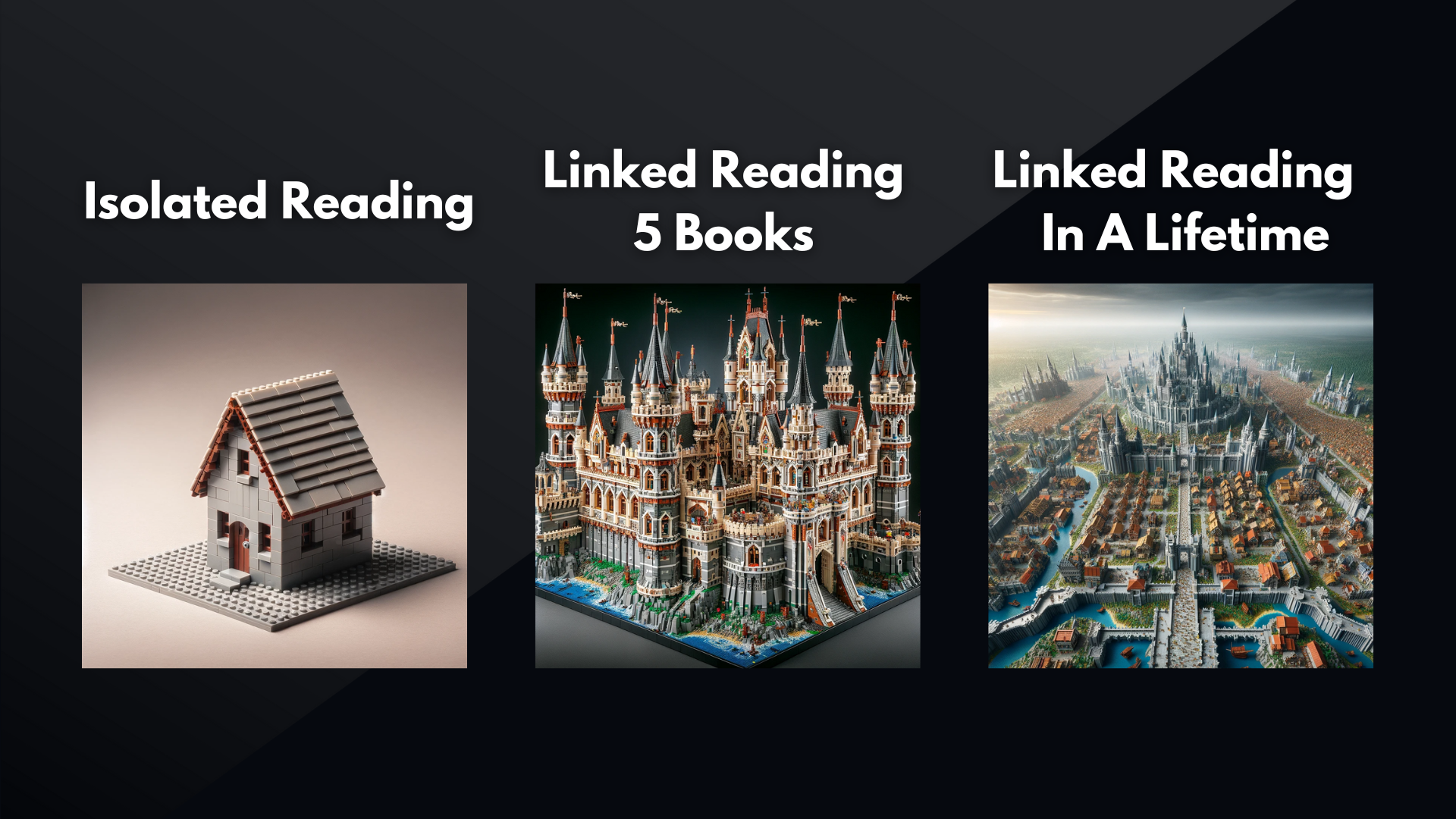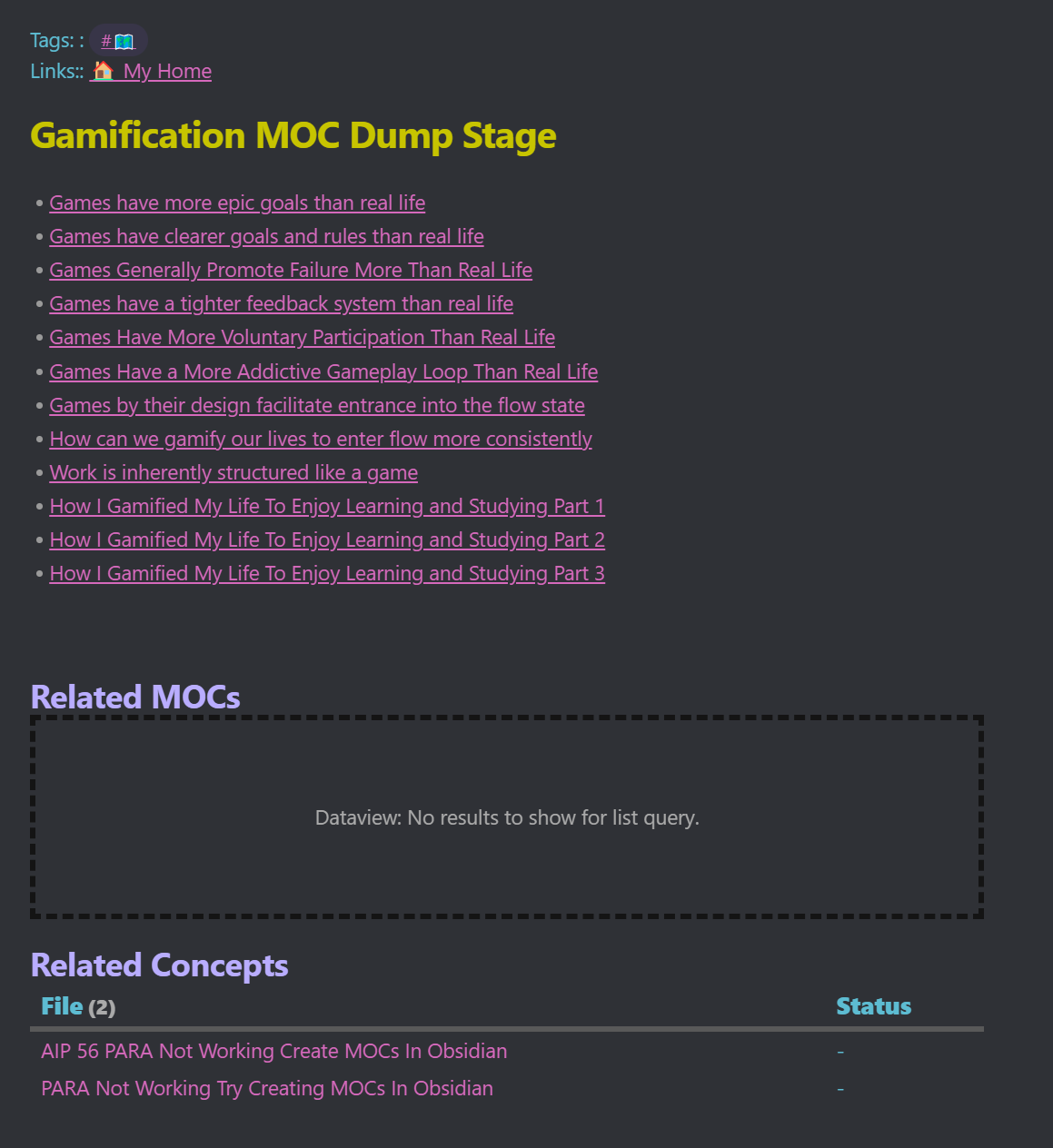🗺️Lesson 3: How To Compound Your Knowledge With Maps Of Content
Today's Challenge: Create A Map Of Content
Hello reader!
Yesterday, you learned how to create linked book notes. This lesson will teach you how to compound your knowledge using Maps Of Content. This is where you take the insights you have formed from the last lesson and learn to compound them over your life by linking them to other books and other notes.
Remember the Lego analogy I discussed building in the first lesson?

MOCs are how you build your lego empire.
What Is A MOC?
A map of content is a summation of a bunch of other related notes.
It's quite literally just a normal note in your linked notetaking vault, that links out to a bunch of other notes. You can link out in paragraph form, as a bullet list, through numbers, whatever floats your boat. They can serve as dashboards or overviews in your system and can also serve as hub spots for all of your research on a given topic. But in our case they will mainly serve as hub spots for connecting your book insights together.
However, the skill of creating MOCs expands beyond book reading.
You can use the skills you use in this lesson for creating MOCs using other types of information, to outline projects at work, and more.
Why Should You Create MOCs?
- MOCs allow you to link notes in multiple places. This fixes the major problem of folders, that they don't allow something to be in multiple places at once. And it allows your linked book notes to be linked outside of just your book summary.
- MOC organized systems reduce the need for folders and tags. Instead, you can use links as your primary organization feature.
- MOCs allow you to think bottom-up and top-down. You can grow notes bottom up by creating individual notes, and top down by assembling notes into a MOC.
When To Create MOCs
There are generally two times you should create a MOC:
1. You Hit A Mental Squeeze Point
The mental squeeze point is a term I got from Obsidian YouTuber Nick Milo.
It's the point at which the chaos of your organization becomes so great you have to do something. For example, you create so many notes on Psychology you feel your head will explode.
2. You're Outlining A Project
The second case you can create a MOC is when you are outlining a project.
Let's say you're starting a synoptical reading project on the nature of happiness. Creating a MOC could be super useful for outlining the foundational research question you have, relevant sub questions, and keeping your bibliography for your project.
4 Levels To Creating A MOC
Now that you know why and when you should create MOCs, let's dive into how you create one.
I'm going to take you through the 4 levels of MOC creation using my [[Gamification MOC]] as an example.
Level 1: Creating Isolated Notes
During level 1, you create individual notes on the information you consume throughout your days.
At this level my [[Gamification MOC]] wasn't even created. It was a semblance of a few notes that were mainly created from a old synoptical reading project answering the research question: how can I gamify my life to make studying/learning fun? Therefore this step corresponds to the analytical stage of reading where you are taking individual book notes but haven't linked them together yet.
- [[Games have more epic goals than real life]]
- [[Games have clearer goals and rules than real life]]
- [[Games have a tighter feedback system than real life]]
Level 2: Growing And Connecting Your Notes
In level 2, you start growing and connecting your individual notes together.
Growing your notes involves: Adding more information. Making your note more concise. Providing examples. Connecting them to related notes.
Relationships form. Check out my video [[6 Simple Methods For Creating And Growing Your Concept Notes In Obsidian]] to learn more about creating these relationships.
Those three previous notes, all created from the information I had consumed from Actionable Gamification by Yu-Kai Chou and Reality is Broken by Jane McGonigal, started to connect together.
- [[Games have more epic goals than real life]]
- [[Games have clearer goals and rules than real life]]
- [[Games have a tighter feedback system than real life]]

Level 3: Creating The MOC
At this point, you will want a bird's eye view of the relationships between the notes you connect.
Either you hit your [[Mental squeeze point]], or you are outlining a project. This is when the MOC creation process begins. The creation of the MOC itself takes place over three steps.
Dump
Dumping involves--no not pooping--creating your MOC note, and then dumping every relevant note or even other MOC you can think of inside.
Go back through books you think would be relevant to your MOC and add some of the linked book notes inside.
This is what my Gamification MOC looked like during the dump stage: [[Gamification MOC Dump Stage]].

Lump
In the lump stage, you take all of your dumpings--you better thank me for not making a poop joke--and lump them together based on theme.
Some additional questions you will have to ask during this stage are:
- How should I structure my MOC?
- What notes should I include in my MOC?
- Should I write my MOC in paragraph or bullet list format?
This step corresponds with the third step of the second stage of synoptical reading, defining the issues. Remember in order to define the issues between a number of books we must first construct a neutral terminology, and establish neutral propositions for all authors. Refer back to the lesson on synoptical reading to learn how.
After running through this process with my Gamification MOC, it looks like this: [[Gamification MOC]].

Jump
During the jumping stage, you let your MOC simmer.
No, you don't literally cook it on a stovetop, but you give some time for the ideas to marinate. Then you can come back to the MOC.
Every time I have done this, I find I bring an entirely new perspective to the MOC.
I find new connections and insights.
The jump period lasts an infinite amount of time because you will never truly finish your MOC. You'll continue to navigate using it, grow it, and reflect on the incredible unique knowledge you have just built.
Level 4: Linking MOCs Together-MOCSEPTION
At this level, MOCs are linked to MOCs!
This allows you to rapidly fly around your note library, organically getting unforced behavior-based [[Spaced repetition]].
You can see my [[Gamification MOC]] linked to other MOCs.

The Culmination Of MOC Creation And Linked Book Notetaking
Taken together Linked Book Notetaking and MOC creation allow you to create novel insights that compound over your lifetime.
The end product of my linked book notetaking looks like this for every book I take notes on:
And I currently have over 127 books in my Obsidian database ALL having linked book notes:
Each of these books with linked book notes inside make up MOCs inside of my Obsidian database on topics like Happiness, the Flow State, Gamification, Meaning, Spirituality, Evolution and more. Here is a view of some of my highest order MOCs:
This... This is how you unlock your genius.
You create novel insights through linked book notetaking. These insights can connect to other books which in turn can form MOCs.
Summary Of Creating MOCs To Compound Your Knowledge
If you can get to the level of creating MOCs in your linked reading journey, you will experience incredible results.
MOCs are so valuable for three reasons:
- MOCs allow for linking notes in multiple locations, allowing your book insights to compound over time
- They reduce the reliance on folders and tags, with linking as the main organizational method
- MOCs facilitate both bottom-up and top-down thinking
You create them in two cases:
- You hit a mental squeeze point
- You are starting a synoptical learning project (or other project)
The 4 levels to creating them are:
- Creating Isolated Notes: Starting with individual notes from various sources.
- Growing And Connecting Your Notes: Developing and linking these notes to form relationships.
- Creating The MOC: Using a three-step process involving dumping all relevant book notes (or other notes) into the MOC, lumping them by theme (creating the questions and issues according to synoptical reading), and then jumping, which involves letting the ideas marinate and revisiting them to find new connections.
- Linking MOCs Together (MOCception): Connecting different MOCs to enable a broader perspective and deeper understanding.
🎯Take Action Today
Practice doing level 3 of the MOC creation process by creating a MOC in your notetaking app and going through the dump, lump, jump process.
At this point of the course you have only done linked book notes for a singular book. But that doesn’t mean you can’t start scoping out a MOC you might add to more in the future. So ideate what you want to create a MOC about. Something you know you are interested in and will keep reading about in the future. Take from your twelve favorite questions!
Write down potential MOC ideas you could create below:
Now pick one of those ideas and create a MOC in your notetaking app for it. Because this is your first time creating a MOC don’t make it such a heavy lift. Spend 15-30 minutes creating it. You can always come back and add to it later.
Follow the Dump, Lump, Jump process talked about in the lesson.
🎊Congrats, you completed your last-day action items for the course!🎊
Tomorrow, you will get a celebration email.
